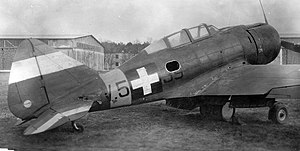MÁVAG Héja
| Héja | |
|---|---|
 |
|
| MÁVAG Héja-II | |
| Role | Fighter |
| Manufacturer | MÁVAG |
| First flight | 1940 |
| Introduction | 1941 |
| Retired | 1945 |
| Primary user | Royal Hungarian Air Force |
| Number built | 204 |
| Developed from | Reggiane Re.2000 |
The MÁVAG Héja ("Hawk") was a Hungarian fighter aircraft based on the Italian Reggiane Re.2000.
In December 1939 seventy Reggiane Re.2000 fighters, purchased from Italy, were delivered to the Magyar Királyi Állami Vas-, Acél- és Gépgyárak, ("Royal Hungarian State Iron, Steel and Machine Works"), where they were modified into MÁVAG Héja I ("Goshawk I") fighters. The original Piaggio P.XI engines were replaced by the Hungarian-built Manfred Weiss WM K-14 driving Hamilton Standard three-bladed, constant-speed propellers. The WM K-14 was a licensed copy of the French Gnome-Rhône 14K engine that necessitated a 1-foot 3-inch lengthening of the fighters’ forward fuselage, to restore the center of gravity to a safe position. The Piaggio engine was itself also a copy of the Gnome-Rhône 14K, but less reliable than the original.
A decision was soon made to produce more Héja fighters under license in Hungary as the MÁVAG Héja II (Goshawk II). The new Héja II was entirely Hungarian with locally produced airframes, engines and armament. The new fighter differed from the Reggiane fighter in a number of ways. Armament was changed to twin 0.50 inch (12.7 mm) Gebauer fixed forward-firing guns in the upper nose with 300 rounds each. Length was 27 ft 6.25 inch (8.39 m), and maximum level speed was 301 mph (485 km/h) at 13,780 ft (4,200 m). Endurance was 2 hours and 30 minutes. The first MÁVAG Héja II took to the air on 30 October 1942, and in total MÁVAG built a further 203 Héjas for the Royal Hungarian Air Force. The last aircraft was completed on 1 August 1944 when production ceased.
The Kingdom of Hungary was allied to Nazi Germany during World War II, with at least one Hungarian squadron flying the MÁVAG Héja in combat on the Eastern Front. However, most Héjas operated inside Hungary in an air defense role or as a trainer.
...
Wikipedia
